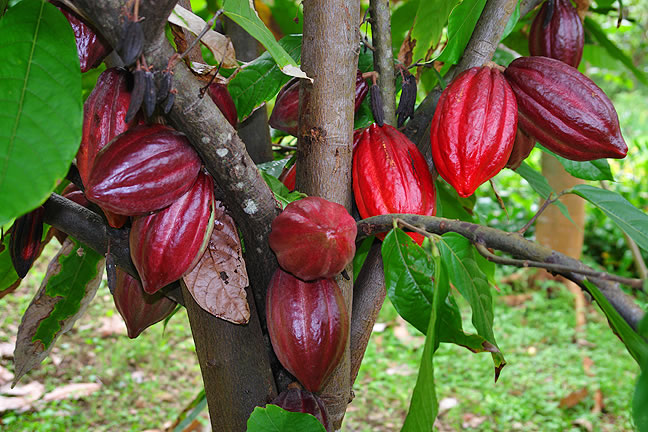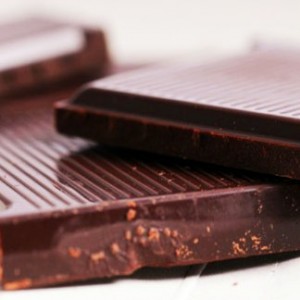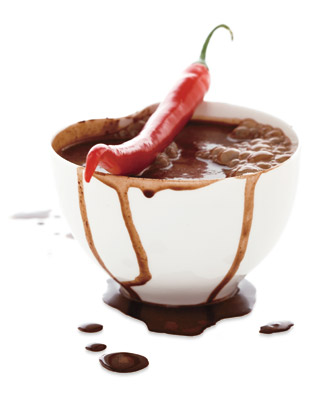Chocolate: it’s sweet, it’s brown, it’s everywhere and in almost everything- chocolate covered bacon anyone? But what we’ve come to known today as a staple of the confectionery shop has its roots in much more bitter and slightly bloody beginnings.
Chocolate comes from the cacao seeds which grow directly on the trunk of the cacao tree, native to tropical regions of Latin America.  Chocolate has it’s root in the Aztec word “xocoatl,” meaning bitter water, it is the name given to the very bitter drink brewed from cacao seeds. The drink was bitter and spicy, a sharp contrast to the milky and sweet chocolate we consume today. The Latin name for the cacao tree, Theobroma cacao, means food of the gods. Mayans believed the cacao tree was discovered by the gods and given to humans. Aztecs believed Quetzacoatal discovered cacao in a mountain with other plant foods. Aztec Emperor Montezuma is alleged to have consumed 50 cups of xocoatl a day. Both Mayans and Aztecs considered cacao drink divine and used it for sacred rituals of birth, marriage, and death. Cacao was only drunk by men and considered toxic to women and children (Theobromines in chocolate indeed make it toxic to animals). Aztec sacrifice victims were given a gourd of cacao, with a splash of the blood of previous victims, to cheer up victims who were too depressed to participate in the customary ritual dance before death (I find this only slightly comparable to my 4AM tear stained Lady Godiva indulgences as I weep silently about the one who got away). This makes sense considering that chocolate has been found to affect serotonin levels in the brain. Alcohol fermented from the pulp of the cacao tree was consumed as early as 1400 BCE. So valued was cacao, that seeds from the tree were used as currency in Pre-Columbian Mesoamerican civilizations, and in the America Revolutionary war it was used as part of soldier rations.
Chocolate has it’s root in the Aztec word “xocoatl,” meaning bitter water, it is the name given to the very bitter drink brewed from cacao seeds. The drink was bitter and spicy, a sharp contrast to the milky and sweet chocolate we consume today. The Latin name for the cacao tree, Theobroma cacao, means food of the gods. Mayans believed the cacao tree was discovered by the gods and given to humans. Aztecs believed Quetzacoatal discovered cacao in a mountain with other plant foods. Aztec Emperor Montezuma is alleged to have consumed 50 cups of xocoatl a day. Both Mayans and Aztecs considered cacao drink divine and used it for sacred rituals of birth, marriage, and death. Cacao was only drunk by men and considered toxic to women and children (Theobromines in chocolate indeed make it toxic to animals). Aztec sacrifice victims were given a gourd of cacao, with a splash of the blood of previous victims, to cheer up victims who were too depressed to participate in the customary ritual dance before death (I find this only slightly comparable to my 4AM tear stained Lady Godiva indulgences as I weep silently about the one who got away). This makes sense considering that chocolate has been found to affect serotonin levels in the brain. Alcohol fermented from the pulp of the cacao tree was consumed as early as 1400 BCE. So valued was cacao, that seeds from the tree were used as currency in Pre-Columbian Mesoamerican civilizations, and in the America Revolutionary war it was used as part of soldier rations.
When Spanish invaders landed in Latin America, cacao was one of the drinks served to conquistadors. The Spanish hated the brew, calling it a “bitter drink for pigs,” and it only became popular in Spain when sugar cane or honey was added. Thus began what we have come to know as chocolate. The cacao seeds were dried, roasted, shelled, ground, and then liquefied to make chocolate liqueur (it contains no actual alcohol). In 1828 a Dutch chemist made powdered chocolate by removing the fat from chocolate liqueur, producing cocoa butter, and treating the nonfat mixture with alkaline salts to alleviate the bitter taste, and was later known as “Dutch” chocolate. Previously, chocolate was considered a drink rather than a solid food. The first chocolate bar was sold by Fry’s chocolate factory located in Bristol England in 1847. Later, Cadbury and Nestle pioneered milk chocolate into what we know today.
While milk chocolate is high in fats and sugars, dark chocolate has been proven to have medicinal benefits. Dark chocolate is rich in antioxidants that benefit the body. According to an article in the Journal of American Medical Association, polyphenol rich dark chocolate was shown to improve blood pressure in those with mild high blood pressure. However the milk in white and milk chocolate may interfere with the body’s absorption of antioxidants. When it comes to health, the darker the chocolate the better. However, this isn’t an open invitation to gorge on Hershey’s Extra Dark. The benefits come with a significant caloric price. As with most things, all is well in moderation.
However the milk in white and milk chocolate may interfere with the body’s absorption of antioxidants. When it comes to health, the darker the chocolate the better. However, this isn’t an open invitation to gorge on Hershey’s Extra Dark. The benefits come with a significant caloric price. As with most things, all is well in moderation.
Whether you’re treating yourself after a long day, getting a gift for someone, or trying to cheer yourself up before ritual sacrifice, chocolate is the way to go.
Pick up some hot chocolate or coffee at The Bean.

Catherine, Hudson County Community College, Read my blog and follow me on Twitter
Click here to download the Campus Clipper iTunes App!
Follow Campus Clipper on Twitter or keep current by liking us on Facebook
Interested in more deals for students? Sign up for our bi-weekly newsletter to get the latest in student discounts and promotions and follow our Tumblr and Pinterest. For savings on-the-go, download our printable coupon e-book



